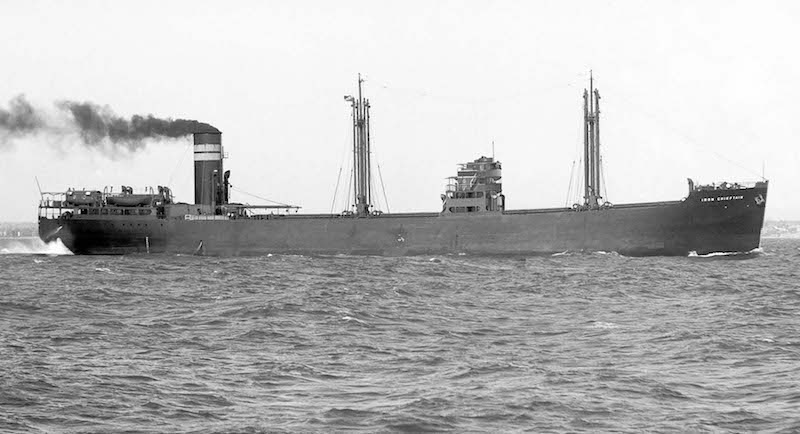
At 1100 hours 3rd June 1942 BHP’s Iron Chieftain sailed from Newcastle on her ill- fated voyage to Whyalla with her cargo of coke and ship building construction material for the ships being built at the Whyalla yard. Later that evening at 2240 hours while steaming at about six knots due to a heavy swell she was torpedoed and sunk by the surfaced Japanese submarine 1-24 in a position 27 nautical miles east of Sydney.
The torpedo struck the vessel port side amidships and resulted in the loss of the ship which sank quickly by the stern, taking with it 12 Officers and Crew. These included both the Master, Captain Haddelsey and Chief Engineer, Mr. M. Gunn whose names are included amongst those lost on the Newcastle memorial plaque. Twenty five of the crew including three seriously injured crew escaped from the stricken ship in the starboard lifeboat under the command of Second Officer, Mr. Phillip Brady. As navigator Mr. Brady steered the boat towards the coast finally arriving off a beach near The Entrance at 1800 4th June . The decision was then made to delay landing until daylight the next morning which resulted in the lifeboat spending 38 hours afloat. The lifeboat was later salvaged and returned by truck to Newcastle. The news of the loss was published on the 5th June both on the radio and in the press, a practice that saw censorship immediately implemented for security reasons. HMAS Bingera (a Merchant Ship requisitioned by RAN from the A.U.S.N. Company ) was dispatched from Sydney and picked up the remaining 12 survivors from a liferaft the following day. Two hours before, Howards Smith’s Age on passage to Newcastle had been attacked by gunfire by the same submarine in almost the same vicinity 35 miles South East off Norah Head.
The following day, 4th June 1942 a second Newcastle crewed ship, Iron Crown, owned by Interstate Steamships Pty Ltd., was torpedoed and sunk by the Japanese submarine I-27 at 1645 hours in a position 44 nautical miles SSW of Gabo Island, Victoria while on passage from Whyalla to Port Kembla with a cargo of iron ore. The torpedo struck the deeply loaded ship on the port side abaft the bridge and the ship sank quickly in 60 seconds resulting in the loss of 37 of her 42 man crew. The five survivors were rescued by the British ship Mulbera. But for a judicious alteration of course BHP’s Iron King sister ship of Iron Chieftain would have been in the exact position to that of the Iron Crown and witnessed the sinking.
In the same area Adelaide Steamship’s Barwon had been attacked with gunfire and torpedoes at 0540 hours that morning by the same submarine 33 miles SSE of Gabo Island but survived.
The Japanese forces with their attack and sinking of these Australian Merchant ships in Australian waters heralded the first hostile act in which 28 ships were sunk or attacked off the East Coast.
The Merchant Navy barely receives a mention in popular WW 2 history except for HMHS Centaur.
The Forgotten and ignored Fourth Service.
Captain Phillip Brady OAM later became BHP’s popular and respected Marine Superintendent and was a member of the CMMA
Source: Captain Iain Steverson

